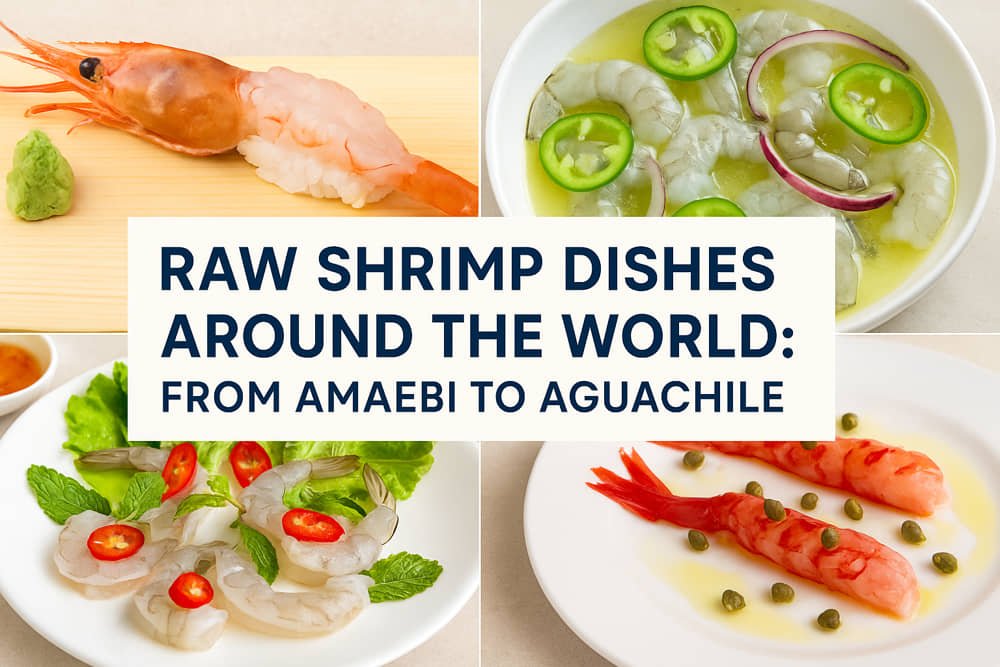Raw shrimp is a global delicacy with diverse cultural expressions. From Japanese amaebi to Mexican aguachile, raw shrimp dishes offer regional interpretations that reflect local traditions, flavor profiles, and food safety practices. These dishes are not mere novelties—they’re central components of national cuisines where freshness, texture, and preparation technique play a defining role.
This article explores raw shrimp preparations across Asia, Latin America, and Europe, explaining exactly how each dish is served, which ingredients are used, and how health standards are maintained. Whether you’re a curious eater or a culinary professional, this guide will help you understand the cultural, gastronomic, and hygienic nuances behind raw shrimp dishes worldwide.
Contents
- 1 What are raw shrimp dishes and how are they different across cultures?
- 2 What is amaebi (sweet shrimp) and how is it served in Japan?
- 3 What is aguachile and how does it showcase raw shrimp in Mexico?
- 4 What are some other raw shrimp dishes from Asia?
- 5 Which European cuisines include raw shrimp preparations?
- 6 What types of shrimp are suitable for raw consumption?
- 7 How do different cultures ensure raw shrimp is safe to eat?
- 8 What condiments, sauces, or sides pair well with raw shrimp?
- 9 How should raw shrimp dishes be stored and served at home?
- 10 Where can you try authentic raw shrimp dishes around the world?
What are raw shrimp dishes and how are they different across cultures?
Raw shrimp dishes are culinary preparations that use uncooked shrimp, typically marinated or chilled, and vary widely between regions based on flavor, technique, and cultural symbolism.
There are 3 primary cultural zones where raw shrimp is commonly consumed:
- Japan and East Asia: Shrimp is served raw in sushi, sashimi, or fermented forms such as amaebi or saeujeot. The focus is on sweetness, translucence, and precision in knife work.
- Latin America: Countries like Mexico and Peru feature raw shrimp in acidic marinades, most notably aguachile and ceviche. The emphasis here is on spice, citrus, and freshness.
- Mediterranean and Southeast Asia: Raw shrimp appears in Italian crudo or Thai seafood salads, highlighting extra virgin olive oil, chili, or lime-based dressings.
Each region uses specific local species of shrimp, distinct preparation methods, and unique ingredient pairings. For example, while Japan uses cold-water sweet shrimp (Pandalus borealis), aguachile relies on warm-water shrimp combined with serrano peppers, lime, and onions.
What is amaebi (sweet shrimp) and how is it served in Japan?
Amaebi is a type of cold-water shrimp known for its sweet flavor and is served raw in Japanese sushi and sashimi dishes.
There are 2 defining characteristics of amaebi:
- Flavor and Texture: Amaebi has a high glycogen content, which produces a natural sweetness. Its flesh remains tender and glossy, even when raw.
- Presentation: In sushi bars, amaebi is usually served as nigiri—over vinegared rice—or as sashimi with wasabi and soy sauce. Often, the heads are deep-fried and served on the side.
Japanese chefs follow strict hygiene protocols, including flash freezing at –20°C for at least 7 days, to eliminate parasites before serving raw.
Amaebi is typically sourced from Hokkaido, Canada, or Greenland and is consumed within 24–48 hours after thawing. Its popularity in omakase dining underscores its role as a premium ingredient in raw seafood cuisine.
What is aguachile and how does it showcase raw shrimp in Mexico?
Aguachile is a Mexican dish that features raw shrimp marinated in lime juice, chili, cilantro, and cucumber, served immediately to preserve the shrimp’s texture.
There are 4 key elements in authentic aguachile:
- Raw, fresh shrimp: Usually butterflied and deveined to maximize lime exposure.
- Serrano or jalapeño chilies: Crushed or blended with lime juice to form the marinade.
- Red onions and cucumber slices: Used for crunch and contrast.
- Immediate preparation: Unlike ceviche, aguachile is eaten minutes after marination, keeping the shrimp slightly translucent and texturally firm.
The dish originates from the coastal state of Sinaloa and has spread to restaurants across Mexico and the United States.
Its popularity is growing due to its bold flavor and minimal preparation time. Unlike ceviche, which chemically “cooks” shrimp for 15–30 minutes, aguachile emphasizes raw texture and fresh heat.
What are some other raw shrimp dishes from Asia?
Several Asian countries incorporate raw shrimp into local dishes through fermentation, marination, or live presentation.
There are 3 notable examples:
- Saeujeot (Korea):
Saeujeot is a Korean condiment made by fermenting tiny raw shrimp with salt. The shrimp undergo lacto-fermentation over several months and are used as seasoning for kimchi and stews. The fermentation process produces umami compounds like glutamic acid. - Gỏi tôm sống (Vietnam):
This dish uses live or freshly killed shrimp served with herbs, lime juice, chili, and fish sauce. The shrimp are briefly chilled but not chemically cooked, preserving their texture. It is consumed in rural and coastal regions, often with rice crackers. - Yum Goong Sod (Thailand):
Thai seafood salads occasionally feature raw shrimp mixed with chili, garlic, lime juice, and fish sauce. The shrimp are deveined and mixed moments before serving. These salads rely on balance between heat, acidity, and freshness.
All of these dishes are served either immediately or under cold conditions to reduce bacterial activity.
Which European cuisines include raw shrimp preparations?
Italy is the primary European country known for raw shrimp, featured in crudo-style seafood dishes.
There are 2 key styles in Italian cuisine:
- Gambero rosso crudo (Southern Italy):
Red Mediterranean shrimp are shelled, deveined, and served raw with extra virgin olive oil, lemon zest, and sea salt. This is a staple of high-end seafood menus in regions like Puglia and Sicily. - Scampi crudo (Venice and Liguria):
Langoustines (Norway lobster) are served raw with microgreens or citrus dressing. Though technically not shrimp, they fall within the same culinary context in Mediterranean seafood traditions.
Outside Italy, Scandinavian countries focus more on cured or lightly pickled shrimp rather than raw. These include gravlax-style preparations or brined shrimp in Denmark and Sweden, but rarely true raw presentations.
What types of shrimp are suitable for raw consumption?
Only certain species of shrimp are safe and suitable for raw consumption, based on origin, water temperature, and harvest method.
There are 3 main criteria:
- Species type:
- Cold-water species like Pandalus borealis (sweet shrimp) and Parapenaeus longirostris (deep-sea shrimp) are preferred due to lower parasite risk and firmer texture.
- Avoid tropical shrimp for raw use unless parasite treatment is verified.
- Harvest method:
- Wild-caught shrimp from deep, clean waters are favored in raw preparations.
- Farmed shrimp are acceptable only when certified for sushi-grade standards and subjected to freezing at –20°C for at least 7 days.
- Parasite and pathogen control:
- Shrimp used in raw dishes must be frozen in compliance with regulations such as U.S. FDA’s Food Code or Japan’s food hygiene standards.
- The term sushi-grade or sashimi-grade is not regulated but indicates vendor commitment to food safety.
Always verify the supplier’s freezing protocol and country of origin before consuming raw shrimp.
How do different cultures ensure raw shrimp is safe to eat?
Different cultures use freezing, fermentation, and acid-based marinades to ensure raw shrimp is safe for consumption.
There are 3 main safety strategies:
- Freezing (Japan, U.S., EU):
Regulatory bodies like the FDA and EFSA require seafood intended for raw consumption to be frozen at –20°C for 7 days or –35°C for 15 hours. This process kills parasites such as Anisakis simplex, which are commonly found in wild shrimp. - Acid curing (Latin America):
In Mexico and Peru, raw shrimp dishes like aguachile or ceviche rely on citric acid from lime or lemon to denature proteins and lower surface microbial loads. However, this does not kill parasites, so shrimp must still be previously frozen. - Fermentation (Korea):
Saeujeot undergoes salt-based anaerobic fermentation, which changes pH and inhibits pathogen growth. This method also produces lactic acid, contributing to preservation and flavor enhancement.
Regardless of the cultural context, raw shrimp is always subjected to a control step—freezing, curing, or fermenting—to mitigate microbiological risks.
What condiments, sauces, or sides pair well with raw shrimp?
Raw shrimp is typically paired with sauces and sides that enhance sweetness, contrast texture, or add acidity.
There are 4 popular condiment profiles:
- Soy-based (Japan):
Amaebi is served with light soy sauce, grated wasabi, and sometimes shiso leaf. These elements enhance umami and aromatic freshness. - Citrus-chili (Mexico, Thailand):
Aguachile and Thai shrimp salads use lime juice blended with serrano, bird’s eye chili, and cilantro to add brightness and heat. - Fermented (Vietnam, Korea):
Shrimp in gỏi or saeujeot is accompanied by fermented fish sauce or anchovy paste, intensifying salinity and complexity. - Olive oil-based (Italy):
Crudo dishes include extra virgin olive oil, sea salt, lemon zest, or capers. These additions preserve the shrimp’s delicate flavor and offer textural balance.
The condiment varies by region but consistently serves to complement the shrimp’s natural flavor while balancing pH, fat, and spice.
How should raw shrimp dishes be stored and served at home?
Raw shrimp must be kept at temperatures below 4°C and served within 24 hours of thawing to maintain safety and texture.
There are 3 essential home preparation rules:
- Storage temperature:
Always refrigerate raw shrimp between 0–4°C (32–39°F). Do not store in standing water or sealed containers without air. - Time limit after thawing:
Frozen, sushi-grade shrimp should be consumed within 24 hours of defrosting. Beyond that, bacterial growth accelerates even under refrigeration. - Serving environment:
Use chilled plates and avoid serving under warm lighting or open-air buffets. Ideally, plate the shrimp immediately before eating and return leftovers to cold storage within 30 minutes.
Improper handling at home is a leading cause of raw seafood-related illness, despite high-quality sourcing.
Where can you try authentic raw shrimp dishes around the world?
Authentic raw shrimp dishes can be found in high-end sushi restaurants, coastal eateries in Latin America, and Mediterranean seafood establishments.
Here are 3 specific destinations:
- Tokyo, Japan – Amaebi at Sushi Saito:
Sushi Saito (3 Michelin stars) serves amaebi in its purest form—aged precisely for texture, hand-formed over seasoned rice, and accompanied by deep-fried heads. Shrimp is sourced from Hokkaido or the Sea of Okhotsk. - Mexico City or Sinaloa – Aguachile at Mariscos El Cata:
This coastal-style seafood vendor prepares aguachile using Pacific white shrimp, serrano chili, and red onions. The shrimp is frozen for safety, then marinated just before serving to retain translucency. - Lecce, Italy – Crudo di gambero rosso at Bros’ Restaurant:
Bros’ offers crudo with red Mediterranean shrimp, lemon emulsion, and olive dust. Shrimp is served at exactly 8°C to balance taste and food safety. This dish highlights minimalism and ingredient purity.
Look for restaurants that clearly label shrimp as “previously frozen” or “sushi-grade,” especially when dining outside traditional regions.
To ensure food safety when preparing at home, see our guide on How to choose sushi-grade seafood.
For a broader understanding of raw consumption risks, visit Can You Eat Shrimp Raw?.
If you’re exploring Japanese cuisine further, learn more from our breakdown of Japanese raw seafood traditions.



